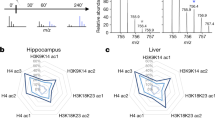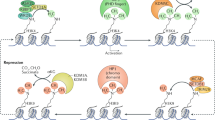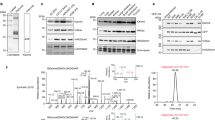Abstract
No function has been found for the methylation of the ɛ-N-amino group of lysine in certain histones that have been demonstrated in thymus gland, liver and erythrocytes as well as several other organs1. It has been suggested, however, that this modification of the histone polypeptide effects the DNA-histone interaction and may be involved in regulating gene expression1. Methylation appears to be very specific, occurring after histone synthesis is complete2. Methylation of certain histones can be correlated with development. Gershey et al. reported that 3-methylhistidine was formed more rapidly in immature erythroid cells than in mature erythrocytes3, and Borun et al. found that in developing HeLa cells the lysyl residues of F2b, F3 and F2a1 histones were methylated mainly in the G2 phase and during mitosis4. Methylation of rat brain histones also seems to depend on age. After the intraperitoneal injection of L-14CH3-methionine into different age classes of rats we found that only trace amounts of 14C-methyl were incorporated into brain histones after maturity5. If L-3H-lysine and L-14CH3-methionine are administered to newborn rats biphasic type decay curves (3H and 14C) are obtained for all histone subfractions. During brain development (up to 50 d) the arginine-rich histones have a halflife of 32 d while no turnover is observed after maturity as measured by either 3H or 14C decay. We now find that the level of the histone methylases and the ability of brain histones to accept methyl groups decreases during ageing. Freshly prepared brain and liver nuclei from rats of various ages were incubated with C3H3-S-adenosylmethionine. The reaction mixtures were chilled to 0° C, the nuclei centrifuged down and extracted three times with 0.14 M NaCl. The residue was washed with methanol–chloroform, acetone, acetic acid (pH 3.0) and the histones extracted with 0.4 M HCl6. When L-14C-lysine was added to the reaction mixture no 14C was incorporated into the resultant histones excluding in vitro synthesis of histone in our system.
This is a preview of subscription content, access via your institution
Access options
Subscribe to this journal
Receive 51 print issues and online access
$199.00 per year
only $3.90 per issue
Buy this article
- Purchase on Springer Link
- Instant access to full article PDF
Prices may be subject to local taxes which are calculated during checkout
Similar content being viewed by others
References
Allfrey, V. G., in Histones and nucleohistones (edit. by Phillips, D. M. P.), 241 (Plenum, London, New York, 1971).
Tidwell, T., Allfrey, V. G., and Mirsky, A. E., J. biol. Chem., 243, 707 (1968).
Gershey, E. L., Haslett, G. W., Vidali, G., and Allfrey, V. G., J. biol. Chem., 244, 4871 (1969).
Borun, T. W., Pearson, D., and Paik, W. K., J. biol. Chem., 247, 4288 (1972).
Duerre, J. A., and Lee, C. T., J. Neurochem, 23, 541 (1974).
Duerre, J. A., and Gaitonde, M. T., J. Neurochem., 18, 1921 (1971).
Burdon, R. H., and Garven, E. V., Biochim. biophys. Acta, 232, 371 (1971).
Paik, W. K., and Kim, S., Biochim. biophys. Acta, 313, 181 (1973).
Bray, G. A., Analyt. Biochem., 1, 279 (1960).
Author information
Authors and Affiliations
Rights and permissions
About this article
Cite this article
LEE, C., DUERRE, J. Changes in histone methylase activity of rat brain and liver with ageing. Nature 251, 240–242 (1974). https://doi.org/10.1038/251240a0
Received:
Revised:
Issue Date:
DOI: https://doi.org/10.1038/251240a0
This article is cited by
-
LSD1n is an H4K20 demethylase regulating memory formation via transcriptional elongation control
Nature Neuroscience (2015)
-
Mitochondrial function, mitochondrial DNA and ageing: a reappraisal
Biogerontology (2010)
-
Post-translational changes of chromosomal proteins in rat cerebellum during postnatal development
Neurochemical Research (1983)
Comments
By submitting a comment you agree to abide by our Terms and Community Guidelines. If you find something abusive or that does not comply with our terms or guidelines please flag it as inappropriate.



